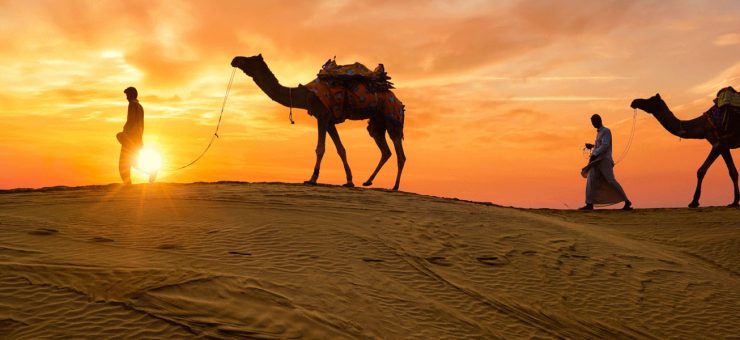A million words cannot conjure up the magic of Rajasthan. Adorned by the majestic Aravalli mountain range, this is the land of the legendary Rajput rulers whose tales of valour, loyalty and love have been woven into ballads and folklore.
This is the land of shifting sand dunes, camels and nomadic cattle herds; of forts and palaces that have been converted into heritage hotels so that rulers of yesteryears, shorn of their privy purses, can live in the vibrant reality of the 21st century.
Despite the apparent poverty of the desert people they are a colorful, happy and proud community. The women wear long, flowing skirts made out of 8 to 10 metres of the most colorful material that stands out in the stark, barren landscape of their terrain. They love chunky silver jewellery and though the veil, which completely covers their face, is worn to hide their beauty from the covetous eyes of men, it also protects them from the harsh sun and sand. The men are tall, dusky and sport with pride their long, twirled moustaches, and often a beard. They wear colorful turbans of red, orange and saffron, often made of the tie-and-dye fabric that is a speciality of the region – and look impressive.
This is the land where water is so scarce that, in village huts, visitors are served milk or buttermilk instead of water. As if to make up for the harshness of their surroundings, the Rajasthani have poured out their creative genius in arts and crafts, in music and dance. Their artistic fingers continue to give stone, clay, leather, wood, ivory, glass, brass, silver, gold and textiles the most brilliant shapes and forms as they breathe life into them. In Baroli, in the Hadoti region, several sculptures have been found proving that an art school existed in the 10th century. The cave paintings, terracotta and other stone sculptures excavated at different sites have confirmed this.
The kings and nobles were patrons of these art forms. So everything was adorned – whether it was the elephants, the donkeys, the palaces, the interiors of forts or the walls of the humble huts. The men rode out to battle on elephants mounted with silver howdah and even their swords and daggers had exquisitely crafted handles. Their mud huts were embellished with intricate patterns on walls and floor. The Rajput rulers were constantly at battle, whether with minor kings or the mighty Mughals. The artisans, however, were encouraged to absorb the refinement and delicacy of the Mughal courts. It was Raja Man Singh of Amer who brought the ‘Meenakari’ craft to Jaipur by inviting skilled enamel workers from Lahore. Today, Jaipur’s Meenakari (Minakari) work (colored enamel work) has acquired world fame.
Lacquer bangles cost just a few rupees but make an excellent gift. In bright colors, the lacquer is gently moulded into shape over burning charcoals, then embedded with fine glass pieces or embellished with gold threads. Ivory bangles are said to be auspicious and women wear them with their bridal attire. From ivory, the Rajasthani craftsmen have also fashioned intricate items of great beauty. Though use of ivory has been banned today, in the old days the finest miniature paintings were made on ivory.
Rajasthan is the ultimate destination of most tourists. Its capital, Jaipur, is just four hours drive from Delhi by road and there are air connections to most cities of the state.
In keeping with its image as the tourist’s favourite haunt, a whole range of sporting facilities is available in Rajasthan, the Camel Safari being the most exciting. For the desert people of Rajasthan the camel is often their only mode of transport through the Thar desert. Started some years ago, the safari takes you through the villages of Shekhawati where mud huts as well as the old ‘havelis'(large houses of nobility and the richer Marwaris or business-men) are adorned with the most intricate paintings. Here you can see and experience rustic Rajasthan. You travel on camel back from Bikaner to Jaisalmer to participate in the Desert Festival or lumber along from Nagaur to Pushkar for the cattle fair. The gait of the camel can be tiring but memorable experience and camel have become extremely popular.
